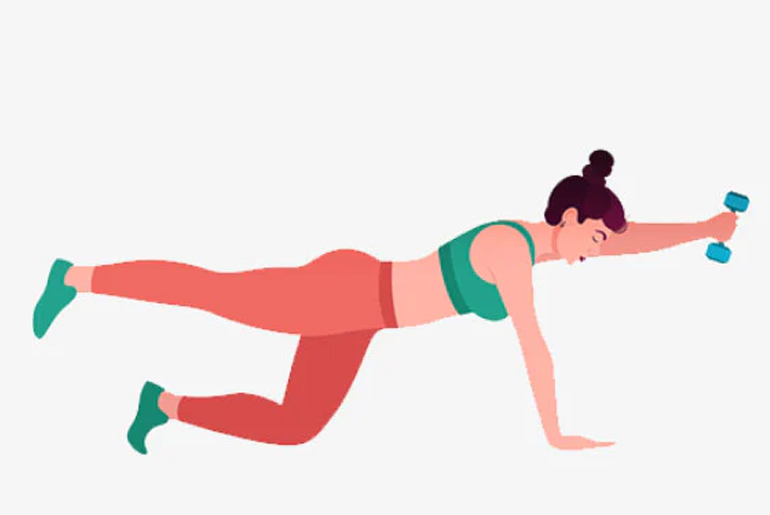The bird dog exercise is an excellent bodyweight workout that targets the core, hips, and back muscles while improving balance and promoting proper posture. This simple yet highly effective move requires no gym equipment—just a mat and enough space to extend one arm and the opposite leg simultaneously. It’s easy to incorporate into a daily fitness routine and can be performed indoors or outdoors, making it a convenient option for strengthening stability and coordination.
Bird Dog Exercise:
The bird dog exercise is a highly effective bodyweight movement that strengthens the core, back, and glutes. According to physiotherapist and fitness expert Dr. Aijaz Ashai, it involves extending one arm forward while simultaneously stretching the opposite leg backward, maintaining a straight line from hand to foot. This exercise is suitable for beginners and elderly individuals, making it an accessible and beneficial workout for improving stability, balance, and posture.
Benefits of the Bird Dog Exercise
- Strengthens the Core: The bird dog exercise is highly effective for engaging both the core and back muscles simultaneously. A strong core improves overall physical function and stability, making daily movements more efficient. According to a 2021 study in the International Journal of Exercise Science, this exercise helps build core endurance, which is essential for maintaining proper posture and preventing injuries.
- Enhances Balance and Stability: By extending one arm and the opposite leg simultaneously, the bird dog exercise activates stabilizing muscles throughout the body. This movement enhances balance, which is crucial for performing everyday activities with ease. A 2016 study published in Rehabilitation Research and Practice supports the idea that bird dog exercises improve balance and stability by engaging the deep core muscles.
- Improves Posture: One of the key benefits of the bird dog exercise is its ability to promote spinal alignment and strengthen the muscles along the spine. A strong and stable spine minimizes the risk of back injuries and improves overall posture. Additionally, a 2019 study in Medicine found that exercises like the bird dog can help reduce lower back pain by enhancing spinal stability.
- Increases Flexibility: The bird dog exercise involves dynamic stretching of the arms, legs, hips, shoulders, and lower back. This movement improves flexibility, which is essential for preventing stiffness and maintaining mobility. Enhanced flexibility also contributes to better movement efficiency and reduces the risk of muscle tightness and injuries.
- Boosts Coordination: Performing the bird dog exercise requires focus and body awareness to maintain balance and stability. This improves coordination, allowing for better control of movements. Enhanced coordination can benefit various physical activities and sports, making movements more precise and controlled.
How to Perform the Bird Dog Exercise
Starting Position
- Get on all fours, ensuring your wrists are directly beneath your shoulders and your knees are aligned under your hips.
- Keep your spine neutral and align your head with your back to maintain proper posture.
Movement
- Slowly extend your right arm straight in front of you, keeping your thumb pointed upward.
- At the same time, extend your left leg straight back, ensuring it remains parallel to the floor.
Alignment & Stability
- Maintain a straight line from your right hand to your left foot.
- Keep your hips squared to the ground and engage your core muscles to stabilize your body.
Hold & Return
- Hold this position for a few seconds while maintaining control.
- Gradually return your arm and leg to the starting position without arching your back.
Repetitions
- Perform 10 to 15 reps per side, adjusting based on your fitness level.
Common Mistakes to Avoid in the Bird Dog Exercise
- Arching Your Lower Back: Overarching the lower back while extending your arms or legs can put unnecessary strain on the spine. To avoid this, maintain a neutral spine throughout the movement. Keeping your back flat and aligned ensures the exercise remains safe and targets the intended muscles effectively.
- Overextending Limbs: Extending your arm and leg too far may cause you to lose balance and disrupt proper form. Focus on controlled and deliberate movements, extending only as far as you can while maintaining core engagement and stability.
- Sagging Hips: Allowing your hips to drop during the movement shifts excess pressure to the lower back. To prevent this, keep your hips in line with your shoulders and knees. Think about keeping your pelvis level and square to the floor.
- Not Engaging Your Core: Failing to engage your core results in poor stability and reduces the benefits of the exercise. Always draw your abdominal muscles inward to support your spine and help maintain a steady, balanced posture.
Disadvantages of the Bird Dog Exercise
May Be Challenging for Those with Shoulder Pain
- People with existing shoulder pain may experience discomfort while extending their arms.
- Consulting a doctor or physiotherapist before attempting the exercise is recommended.
Limited Strength Gains for Other Muscle Groups
- While it is excellent for core engagement, it does not provide significant strength development for larger muscle groups like the legs or chest.
- Exercises like squats or push-ups may be more effective for full-body strength training.
Despite these limitations, the bird dog exercise remains a great addition to a workout routine for improving core strength, balance, and flexibility.
Disclaimer:
The information contained in this article is for educational and informational purposes only and is not intended as a health advice. We would ask you to consult a qualified professional or medical expert to gain additional knowledge before you choose to consume any product or perform any exercise.







